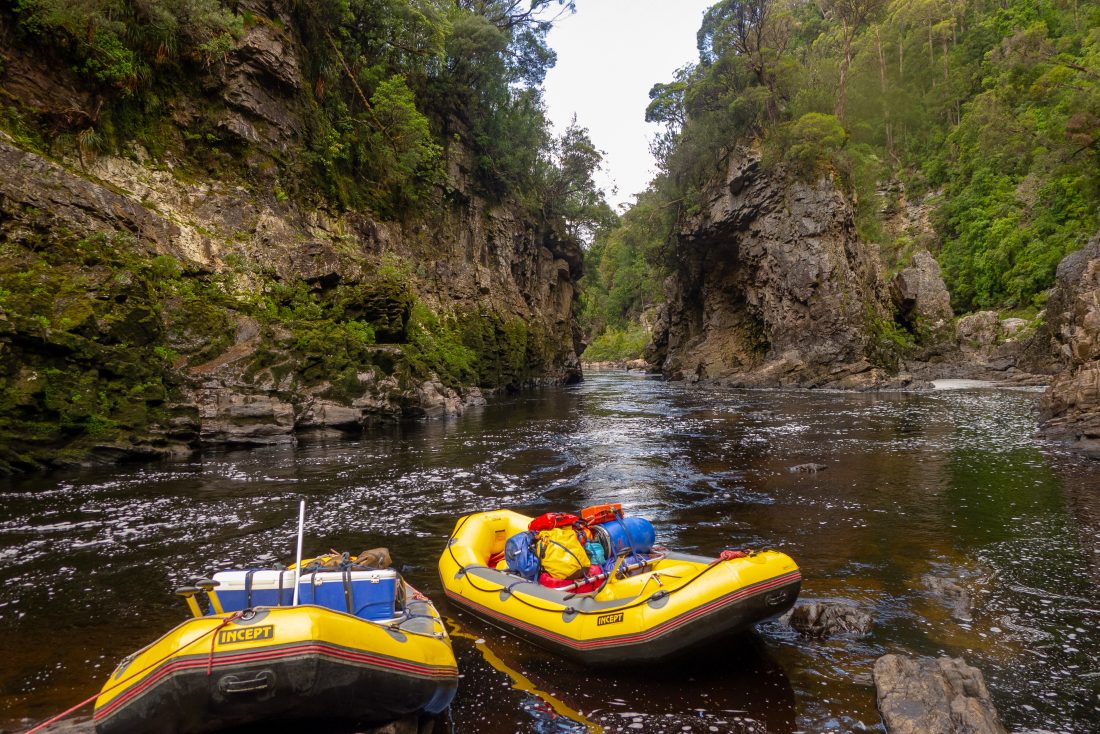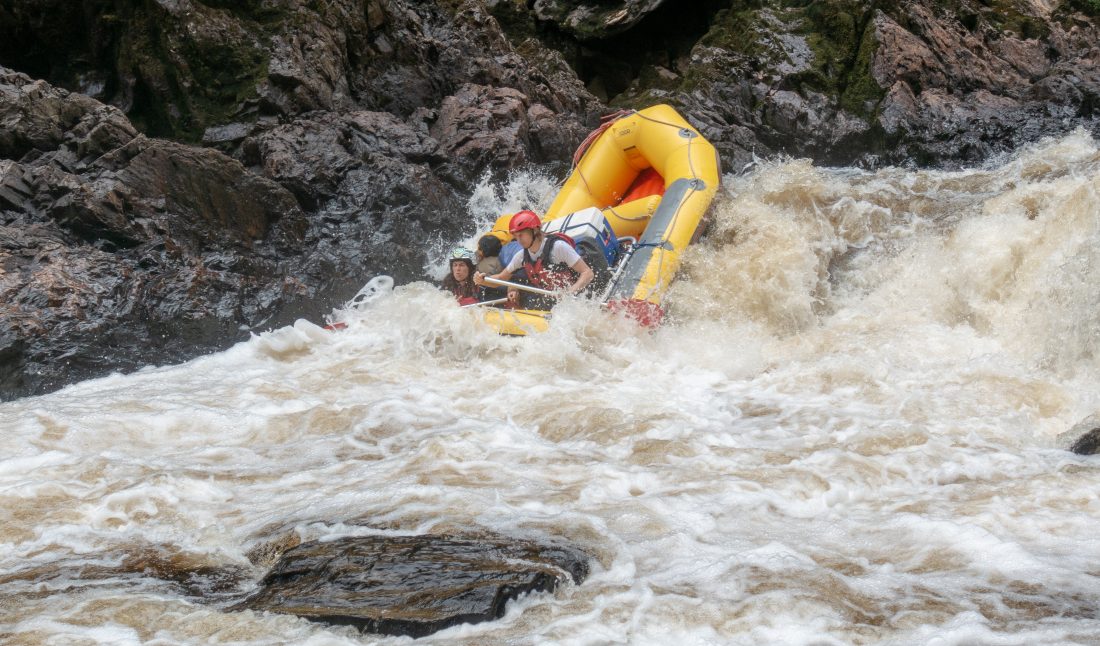By Craig Pearce; with Photos by Royston Pearce
Take 1#: Riding the thunder-rushing tumult between hap-hazard reefs of jagged uber-boulders, avoiding boiling churns at body-trapping ‘sieves’ – relishing crystalline calm pools of respite when you can get them – the Franklin River carries adrenaline junkies through an otherwise impenetrable World Heritage-listed wilderness, on one of the world’s iconic edge-of-the-world adventures.
Take 2#: Managed risk is the steely-eyed-don’t-blink-hold-your-nerve sport grappled with on the Franklin. Without risk, the thrill is gone. And there is an abundance of thrills on this aquatic roller coaster. River guides – a mind-bending proficient entertainment and education in themselves – are the risk management experts.
Take 3#: Death on the Franklin. They have occurred, with many near misses. The river is not for the faint of heart. Its edge is intact (‘widowmakers’ abound) and the legend is in rude health. Deaths have mostly been from kayaking; none from commercial rafting.
Take 4#: This is not – let’s be clear – a journey for ‘passengers’. Significant physical demands are made of those willing to raise it to be rafters. The greater the input from individuals, the more exciting and satisfying it is for the entire rafting team (effective teamwork = success). And portage is not a theory; it is hard work lifting that barge and toting that bale
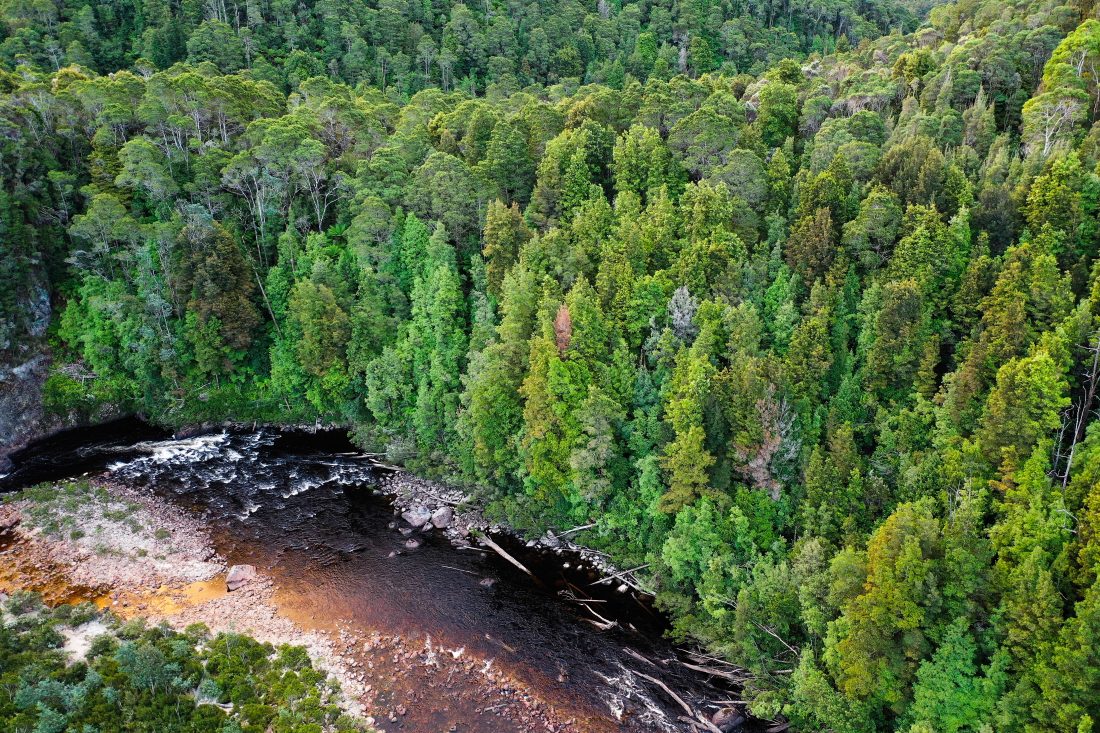
Unless massively experienced, there is no sane way to descend the Franklin without doing so under the care of rafting companies like Water By Nature. The river – and the challenges it presents – can quickly change. A storm can lead to water levels in the upper Franklin increasing by a metre an hour; logs shifting their position; visible rocks ‘dematerialising’. The water itself is also frequently too dark – stained by alpine catchment area peat– or turbid to see into it for hazards.
As a result, navigation is constantly in flux. It demands a high degree of guide expertise and knowledge. They tolerate significant pressure to keep people safe, excited and satisfied their expedition has pushed them past, but perhaps not too far past, their tolerance envelopes for physical demands and safety.
Ultimately, however, each participant is accountable for their own safety and for contributing to that of their fellow paddlers’, too. There are limited supplies of cotton wool on the Franklin in which individuals can be insulated.
Shooting the Franklin
Approaching Descension Gorge, tranquillity was about to be ruptured. It was like the dawn of sound, a tsunami of aural shrapnel shredding serenity’s whispers; audio compressed into an overwhelming percussive roar. Adrenalin, anticipation and trepidation – all ratchet up in any approaching paddler’s chest. The running of the rapids – Spanish bulls in the bush – was about to begin.
‘Hard right; harder’, she yelled, struggling to be heard over the river’s jet engine noise assault.
The awareness of sound subsided as mid-river blocks of rocks and a white-water churn loomed around a voluptuous curve of the capricious seducer that is the Franklin. Tensing for the river guide’s calls – they sit high on the stern while we paddlers are perched, feet desperately seeking traction, on the raft’s pneumatic gunwales – we zoned in on the elemental moment, the here and now – disaster or jubilation?
‘Back left’ (here we go!) was the first terse command, so left-sided paddlers worked backwards while those on the right went forward. ‘Forward right’; the left side paddlers stopped. ‘Everyone hard’; we all paddled forward. ‘Harder, harder!’, we’re berated, so the team dug into the water with muscle fibre-busting might, ignoring blades smashing into rocks, in the hope sufficient traction and boat speed were gained – the intent being to match the velocity of the water as it streamed through the slots.
The guide tweaked direction from behind, using the outboard engines sitting in front of her for power, though only as a complement to the main source of propulsion – the river’s flow.
Whooping as we wended over one, two, three sets of close-together rapids, with not much more than a scrape and minor ricochet or two, we came up against a trademark Franklin challenge: a series of drops and tight navigational puzzles that demanded a more complex technical solution from the guide.
‘Hard right; harder’, she yelled, struggling to be heard over the river’s jet engine noise assault.
We rocketed down a two-metre tiered drop, bounced off a large rock front-right, the stern of the raft swinging around to the left in my favourite – if dizziness inducing! – 360-degree slingshot move, increasing in speed as the current collected us. We blitz bow-first through another archipelago of water-darkened rocks before shake rattle and rolling through more grade 3 rapids (most rapids were grade 2 or 3 on this trip; when the river has more water in it grade 4 are also run) into a calmer stretch of the river, the beatific Irenabyss… all heads swivelling to see how our partner raft, crewed by a free radical motley crue of teenagers, secured its passage.
They blast through a set of chutes cleanly, but snag a submerged rock going down the more technical section.
Enthroned on the rock (thankfully not in a semi-submerged wrap, as the water pressure would have dangerously compromised the raft and all on it), their guide commanded them to all move left on their raft and, for those that can, to paddle back left. It’s not enough; but their upriver side is above water, so they are safe.
Another trademark move – the trampoline – is next. Those who aren’t splayed or squashed by each other in a hilarious monster mash, attempt to bounce the craft off the rock. It’s working, but not enough, so the guide and one of the crew extricated themselves from the raft, balanced precariously on the rock with water streaming through them. They give it a good heave-ho to finally get moving, enjoying a carousel 360 before vaulting out over the final fall in full-throated teenager jubilation, before joining us in our chasm of peace.

Payment in Pain
While paddling had its high-intensity periods as rapids contributed to us descending a whopping 360 metres from start to finish, its physical demands were dominated more by the long haul of knocking off about 110 kilometres over, in our case, a swift four and a half days of paddling.
This resulted in a trip dominated by 12-hour days, long by Franklin standards. With a medium-ish level to the river, we also missed out on the ‘travelator’ effect through the river’s more placid sections. Overall, this contributed to our journey, according to our guides, being physically tougher than most, with the flipside being we were blessed with relatively benign weather. Blue skies on the Franklin! Thank you O River Gods!
As my designated raft position evolved to be left-forward, by the time we’d reached our rafting destination of Sir John Falls, a catastrophic collusion of muscles on the left side of my body felt three times tighter and three times bigger than the right. I made for a very messy scientific experiment.
Most of us had our individual ‘moments’: I rued my complacency when, after a trifling nudge from an unnoticed rock I was abruptly tipped into the drink, my son ripping me roughshod style back into the raft; my right-forward paddling partner, when working a section of the river in tandem with the guide, artfully managed an acrobatic full back flip then, more painfully, suffered a nasty corked thigh from an ugly underwater branch the river threw him against. And just for ‘fun’ he also managed a juddering collision with a rock, corkscrew-twisting his knee. Winces all round.
It is when progression by rafting cannot occur – due to barriers or a rapid being too significant a safety risk to run – when pure strength is seriously called upon. This is when full or partial portaging demands its due. Lining (where ropes are secured to the rafts and they are manipulated over and around obstacles), is often cleverly combined with portaging.

The guides consistently applied a judicious use of strategy, muscle and leadership prowess (e.g. you do this and you do that!). An innovative example of this was at The Cauldron, where they (somewhat incredibly) engineered a ‘boat bridge’, moving one raft onto another, then over it.
Lining and portaging through The Churn presented arguably the biggest physical test. The guides and some crew lined our rafts through a narrow trench, its sides threateningly sheer, making foot purchase and craft manipulation extremely difficult. Meanwhile, portage took place high up the other side of the gorge, entailing wary haulage on a viciously slippery track.
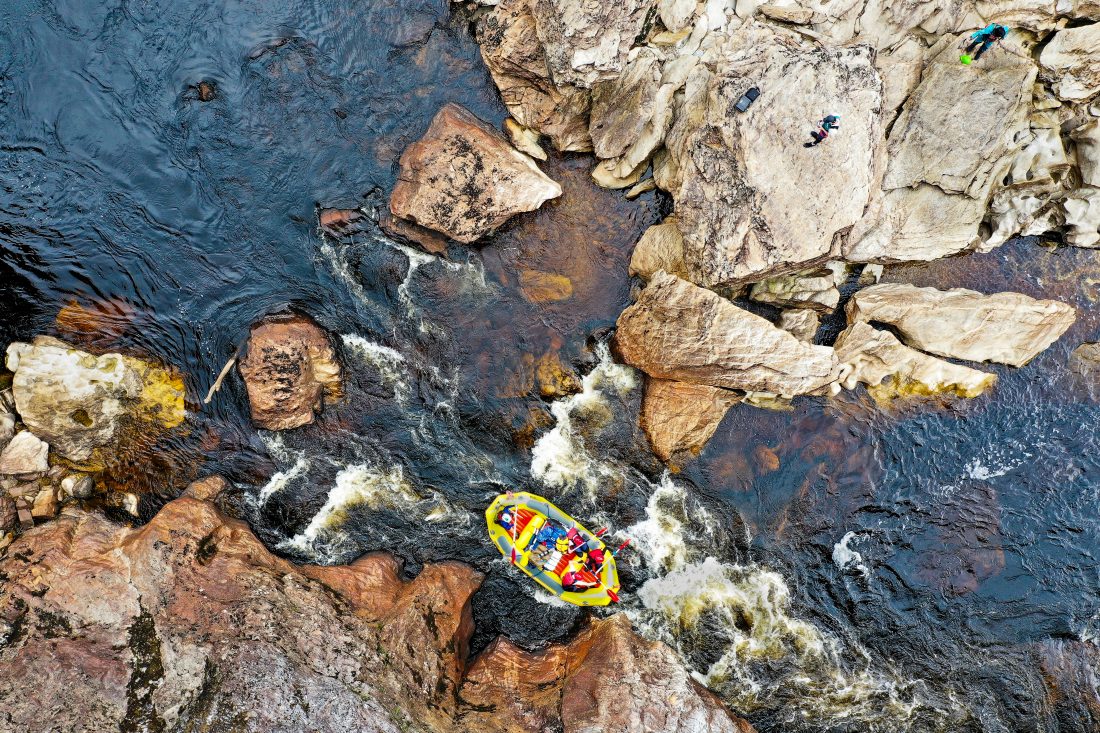
More than a river
The turbulence of the Franklin River goes beyond that of its waters and its weather. More than an iconic wilderness experience alone, it lives large in Australian history as a social, environmental and political battleground – a symbol in numerous ways.
Dreaming by the river, switched off from all but its demands as you alternately race or dawdle through this primaeval environment with its implacable authority, it seems paradoxical to envision it as a place of conflict, but that’s what it most certainly was.
Politicians, industrialists, environmentalists and normal everyday yous and mes – all have had, and still have, a stake in the Franklin and, frequently, there has been scarce common ground. With the spin fabricated these days by ‘power people’ in regard to mining, logging and/or agri-industry in the context of sacred places such as the Great Barrier Reef, the Tarkine and the Great Australian Bite, it’s depressing to consider whether lessons really have been learned through the Franklin imbroglio.
I think they have, but the relentless persistence of corporates to leverage and exploit anything they can profit from (for the dreaded ‘shareholder return’), and the reliability of politicians rolling over when anything resembling a vote or campaign funding looks like heading their way, make me wonder.
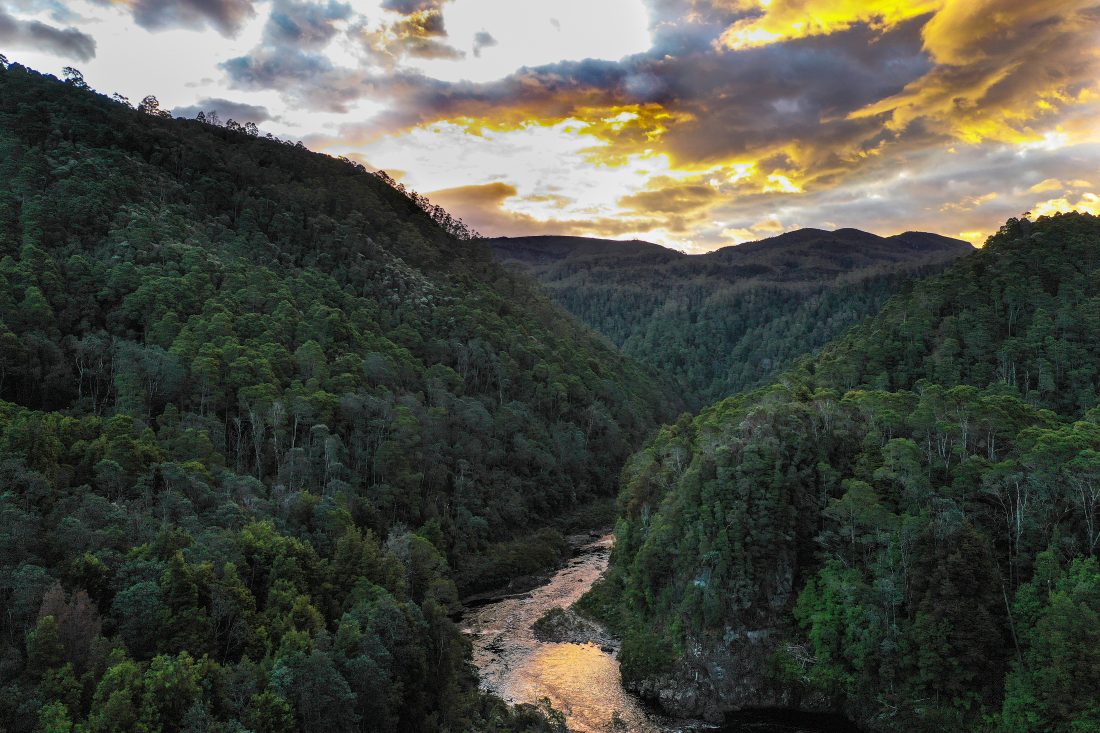
During the ‘No Dam’ controversy of the early 80s, the Franklin-Gordon River area was ratified by UNESCO as being a World Heritage Area. Contained in the Franklin-Gordon Wild Rivers National Park in the central and western parts of Tasmania., it is now one of many national parks and reserves that make up the Tasmanian Wilderness World Heritage Area.
The political bottom line of the long fight to save the Franklin from being dammed was a High Court ruling in 1983. This supported the Labor Federal Government’s claim that the Federal Government had a constitutional right to ‘legislate on any issue if necessary to enforce an international treaty ‘, thus enabling it to overrule state governments on such matters. It was a contentious ruling, its 4-3 vote revealing as much. Even today it is considered a vulnerable decision, with the potential to be overturned.
If it is ever overturned, impact on the Franklin is unlikely, but it could yet influence outcomes related to the most current significant Tasmanian environmental, social and political issue, the saving of the Tarkine. There are ominous similarities between the Franklin and Tarkine, yet despite its values the latter is struggling to even gain national park status.
It has been argued the Tarkine satisfies many of the ten UNESCO World Heritage Area listing criteria (the Franklin satisfies an astonishing seven, equalled by only one other location in the world, and a place only needs to satisfy one of the criteria to be World Heritage-listed). Like the Franklin endured, the Tarkine is facing determined commercial and political interests to drastically compromise a unique and important wilderness area, one also possessing its own vibrant indigenous heritage.
It is really quite obvious – unless you are a certain breed of politician or business person – the Tarkine needs to be saved.
Paradise
The rapid-packed heart-in-your-mouth helter-skelter is the instant gratification of the Franklin, but the internal stillness (ironic, really, considering the river’s rock’n’roll lifestyle) it evokes is its most lasting physical legacy for the paddler.
Even in movement, there is a placatory stillness (a ‘taming of the beast effect’). A highlight was an extended period of no talking on our raft. We glided on torpid water, our inconsequentialities humbled by this primordial environment, fully subsumed – our minds both conscious and unconscious – within the moment, sensitive to the lullaby of water and bird calls. You could just about hear the whir of our minds creakily slowing down, nature’s gentle serenade energising us.
It wasn’t just a balm we heard, either. Here, sounds comprise a narrative all their own:
- The roar of the rapids was rivalled at one point by a booming tropical thunderstorm, a symptom of the unusually warm weather pattern that accompanied us, closely pursued by a heavy curtain of water, drenching us with its wet warmth
- At night, the calls of southern boobook owls and shining bronze cuckoos alerted us to their presence
- The trees and their children the leaves performed an audiophile’s feast, anything from a susurration to a cacophony; an arboreal orchestra conducted by the weather
Eavesdropping closely, I wondered whether there might be echoes of those who had earlier travelled this way apparent in their aural intimacies: Aboriginals, convicts, explorers, prospectors, aspiring graziers, conservationists and adventurers…

Cormorants – a solo example duck-diving in front of us for an age, smart enough to know we were herding the fish towards it; the silhouette of a v-shaped squadron patrolled past one dusk – often showed themselves. White-bellied sea eagles increased in prevalence the further downstream we travelled. Curlicues of insect-hunting rufus martins, swooping through grottos and caverns, were another frequent feathered entertainment. An early morning platypus we accepted as an augury of good fortune, a gift from the River Gods.
Nearing the Loddon River junction, we encountered our first Huon pines, some of them over 3,000 years old, the females draping their trademark tresses into the river. They enlivened the mass of southern sassafras, fragrant white-flowered leatherwoods, tea tree, pandani and myrtle that congested the cool temperate rainforest into a seemingly infinite tree traffic peak hour. The vegetation was easily the thickest I have ever seen this close – a teeming organic wall of dystopian proportion. Yet much of it was growing under virtually hydroponic conditions, such is the dearth of soil.
Some of the rainforest is remnant Gondwanaland. It takes 800 years for vegetation to reach this level of maturity and density, with fire clearly its enemy (and global warming part of evil’s chasing pack, too). Mosses, ferns, liverworts and fungi abounded.
The greens are embellished by tufts of white flowers from both the exotic sweet-smelling Christmas mintbush and the cliff-loving pendant milligania; the warm red lights of Christmas bells and Tasmanian waratah; and the purples of Western flag irises and trigger plants. You also encounter high walls of sclerophyll – its marquee big boy being swamp gums, which can reach over 100 metres, the world’s second tallest tree.
Unusually for the Franklin, for the first couple of days we were treated to a rare clarity in the water, providing the guides with more navigational knowledge than they are accustomed to, and allowing us to see the crowded underwater landscape. What was below us, however, paled in comparison to the geological drama scrutinising us from above:
- The upper and middle Franklin’s quartzite-dominated landscape was first laid down between 700 million and 1.1 billion years ago
- The lower Franklin’s limestone is about 450 to 500 million years old, it previously having a sub-sea existence

Rock stars were the sheer, towering escarpments of Jericho Walls and Cromleigh Cliff or the more distant perspectives of the mist-wreathed Elliot Range and the sparkling steeple of Frenchman’s Cap, its quartzite throwing refracted fireballs of glare to the Franklin’s incision into Earth.
The 70-metre odd romance of the painted red Blushrock Falls is the glamour turn in the river’s cavalcade of waterfalls. From source to mouth, it is joined by 16 formal tributaries, though its volume is also thickened by innumerable cascades, creeks and soaks, invigorating the river’s flow.
More intimate sculptural fascinations such as Oriel Rock, Mousehole and Masterpiece were also displayed in nature’s gallery, while striking limestone turbo blade-shaped protrusions sliced into the river after Newlands. Contrasting with these cameos were the heroic gorges of Descension, Propsting and The Great Ravine, while visual icons of the ‘resistance’, such as Rock Island Bend and Irenabyss, possessed a serenity in stark contrast to the battle that saved them from inundation.
Moments of truth
On the expedition’s final day after the fun running of Little and Double Falls, and the lining of the deceptive and lethal Big Fall, calmness predominated. We were wonder-walled at Kuti Kina Cave and the serpentine rainforest-packed gulch of the Lost World. The Franklin widened, then merged with the body-shocking cold of the Gordon River, Tasmania’s largest waterway.
Contemplation of our journey and its personal impact began to knead its fingers into our minds, cast off an age ago from their city-constricted moorings. The purpling sky threatened another deluge, but its clouds closed ranks and kept their moisture tight, like our thoughts, too securely bound up in neurons to articulate.
Our relaxed minds were granted even greater freedom the next day as, aboard the yacht Stormbreaker, we peacefully motored down the lower Gordon and across Macquarie Harbour to Strahan. The infamous ex-penal colony, Sarah Island, maintained guard; while Mt Sorrell, stood haughtily back in repose, snuggled in a halo of cloud, a vaulted sapphire-blue sky casting its final blessing over us.
The Franklin River – physically, emotionally and intellectually – did not conquer, so much as overwhelm. Completing this ‘excursion’ (so much more than that!) had been a dream for many years. That dream was brought to life with even greater potency than originally envisaged, because my son, too, was there for the ride.
Our river-borne pageant was a family-characterised one, children being the deliberately bequeathed heirs of the Franklin. Once it was Aboriginals minding the land, then adventurers, then environmentalists, even some selective politicians for a while, before its current chief carers, those who travel down its length (the river’s commercial companies playing a pivotal role here), became its chief custodians and advocates.
Our guides were women, who consistently leveraged their prodigious guile, intellect and physicality in consistently jaw-dropping episodes of power and ingenuity (Amazonian indeed). For me, this enhanced the voyage’s socio-political resonance.
Children inherit the earth. This gift of the Franklin comes with accountability to protect it. Parents on this venture waited until our sons were strong enough – and emotionally mature enough – to thrive through its physicality, enjoy its revelatory moments and grasp some of the river’s significance. Packing the gift into one of nature’s great amusement park rides is the soft sell! As they evolve into adulthood, their work begins.
Wild rafted the Franklin River with the support of Water by Nature, West Coast Yacht Charters and Tourism Tasmania.
